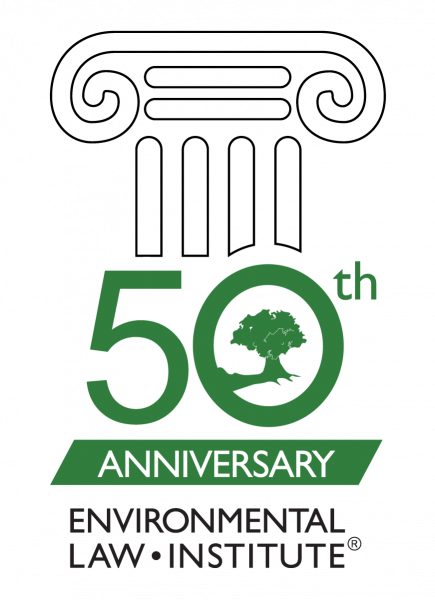My initial thought about this blog was to address a technical chemical regulatory topic, something like “why did it take 40 years for environmental regulators to figure out that perfluorinated compounds contaminate groundwater and don’t degrade over time?” However, this is ELI’s 50th anniversary year, and so I shall talk instead about the work I did over the course of about 15 years with ELI to address chemical regulatory and hazardous waste strategies both in the United States and abroad.
Shortly after I left the Department of Justice in 1982, Elissa Parker of ELI’s staff asked me if I would join an ELI team, on a pro bono basis, in meetings with state environmental regulatory personnel in the Southeast and in the West, the travel costs of which were funded by an EPA grant, to discuss changes in the law and new approaches to addressing chemical contamination and water pollution. I was part of an interdisciplinary group—lawyers, scientists, engineers, and enforcement specialists—who met with the state folks in a series of interactive meetings in which we discussed existing and innovative legal strategies to address remediation of existing contamination of the soil water, identification of sources of contamination, and legal strategies aimed at preventing new contamination.

Subsequently, I participated in a meeting between ELI staff and senior staff people at the Agency for International Development (USAID). The outcome of the meeting was a series of grants to ELI that enabled the Institute to host teams of legal, technical, and economic experts to travel to South America, Europe, and, ultimately, Asia, to provide information and suggestions for innovative approaches to protecting the environment from chemical waste and other sources of environmental contamination and techniques for eliminating or controlling the sources of contamination and remediation of existing contamination. I was asked by ELI to participate in several of these important trips, including São Paulo and Blumenau, Brazil, Lyon, France, Warsaw and Łódź, Poland, and Prague, and, later, in 1997, Sinaia, Romania. Here, are some personal reflections from a couple of those trips.
Philip Warburg, an ELI staff lawyer with broad international experience, Fran Dubrowski, an administrative law expert with a public interest background, and I, an environmental regulatory litigator, traveled to Warsaw shortly after glasnost was declared by Leonid Brezhnev to discuss environmental and waste management regulatory strategies in Eastern Europe in the post-Soviet era. Our discussions with government officials focused on differences between the predominant European approach to dealing with toxic waste and byproducts, and the then-extant approach to the problem as formulated under U.S. law. On our first night in Warsaw, on Polish television, I watched the Berlin Wall being disassembled piece-by-piece by the German people.
When the meetings in Poland were completed, we had to rent a car in Wroclaw to drive over the mountains down to Prague. The only vehicle available was a big BMW sedan, and in it, we set off for to the south of the country. About 30 kilometers from the border, in a rural area, we were pulled over by a police operation that resembled a “Georgia traffic stop,” for allegedly speeding on a road on which there were no posted speed limit signs. We were directed into a barnyard and Philip was issued a summons for many thousands of zloty. Well, none of us kept much zloty, so we negotiated and negotiated and finally the head officer, who sat at a table in the barnyard, agreed to take every last zloty we, collectively, had. We paid the fine and went on our way. Oh, how much did we pay in U.S. currency value? Twenty-eight cents. As we approached the top of the mountain range that separates Poland from Czechoslovakia, the forest disappeared and what replaced it was a veritable wasteland of dead trees as far as the eye could see. It remains somewhat unclear to me what killed the forest, although the Czech officials with whom I discussed the matter opined that acid rain from lignite-burning power plants that operated in East Germany during the Russian occupation was the culprit.
In 1997, when I was Board Chair, I attended an international conference in Romania also, as I recall, funded by USAID, with several ELI staff personnel and several legal, scientific, and economic experts. The conference, which was held in a small city in Transylvania, focused on legal, technical, and economic strategies for the Romanian government to address the significant hazardous waste-related environmental contamination problem in the coastal area of the Black Sea resulting from many decades of large-scale petroleum refining without any meaningful chemical waste management infrastructure. This meeting was interesting in that, in addition to the ELI participants, there were non-legal experts from Poland, Hungary, and several of the Western European countries.
After this limited beginning, ELI significantly expanded its international outreach presence significantly by developing programs in India, China, and elsewhere. These early international efforts provided meaningful input to address some very difficult regulatory problems in societies in which the polluters had historically been government entities, and where industry was slowly being privatized. Interestingly, and perhaps somewhat ironically, the European countries that joined the European Union have developed a chemical regulatory regime that is in many ways far superior to that which exists in the United States, even as it existed before the recent attempts by the Trump Administration to dismantle what we have.